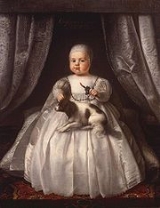
, Scotland
, and Ireland
.
Charles II's father, King Charles I
, was executed at Whitehall
on 30 January 1649, at the climax of the English Civil War
. Although the Parliament of Scotland
proclaimed Charles II King of Great Britain and Ireland in Edinburgh
on 6 February 1649, the English Parliament instead passed a statute that made any such proclamation unlawful. England entered the period known as the English Interregnum
or the English Commonwealth, and the country was a de facto republic, led by Oliver Cromwell
.
1649 The claimant King Charles II of England and Scotland is declared King of Scotland, by the Parliament of Scotland. This move was not followed by the Parliament of England or the Parliament of Ireland.
1650 Third English Civil War: in the Battle of Dunbar, English Parliamentarian forces lead by Oliver Cromwell defeat an army loyal to King Charles II of England and lead by David Leslie, Lord Newark.
1651 Charles II is crowned King of Scotland.
1660 Declaration of Breda by King Charles II of England.
1660 English Restoration: Charles II (on his birthday – see below) is restored to the throne of Great Britain.
1661 King Charles II of England, Scotland and Ireland is crowned in Westminster Abbey.
1661 Marriage contract between Charles II of England and Catherine of Braganza.
1662 Charles II of England sells Dunkirk to France for 40,000 pounds.
1663 Charles II of England grants John Clarke a Royal Charter to Rhode Island.
1665 English King Charles II declares war on the Netherlands marking the start of the Second Anglo-Dutch War.
He had been, he said, an unconscionable time dying; but he hoped that they would excuse it.![]()
Let not poor Nelly starve. ![]()

